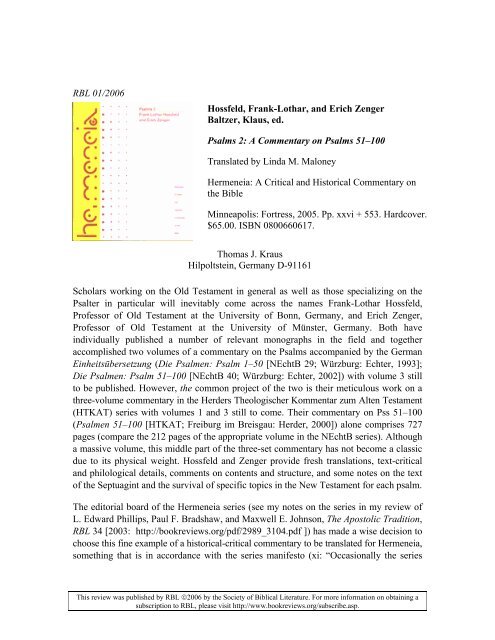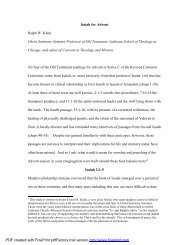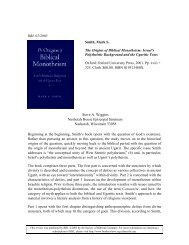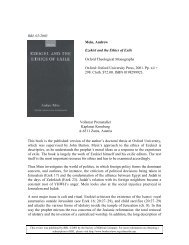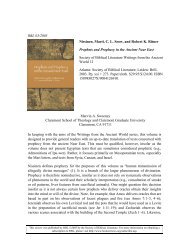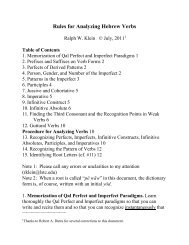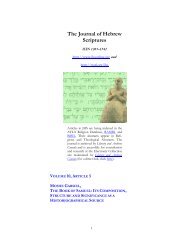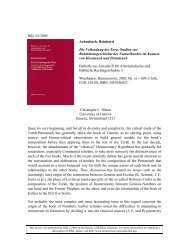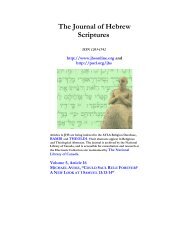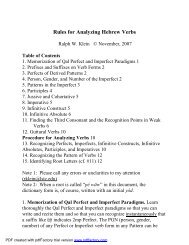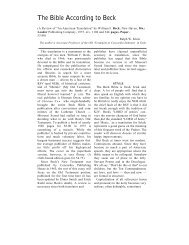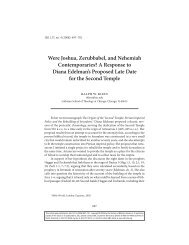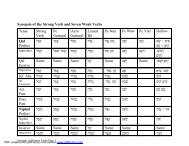Hossfeld, Frank-Lothar, and Erich Zenger Baltzer ... - Fortress Press
Hossfeld, Frank-Lothar, and Erich Zenger Baltzer ... - Fortress Press
Hossfeld, Frank-Lothar, and Erich Zenger Baltzer ... - Fortress Press
Create successful ePaper yourself
Turn your PDF publications into a flip-book with our unique Google optimized e-Paper software.
RBL 01/2006<br />
<strong>Hossfeld</strong>, <strong>Frank</strong>-<strong>Lothar</strong>, <strong>and</strong> <strong>Erich</strong> <strong>Zenger</strong><br />
<strong>Baltzer</strong>, Klaus, ed.<br />
Psalms 2: A Commentary on Psalms 51–100<br />
Translated by Linda M. Maloney<br />
Hermeneia: A Critical <strong>and</strong> Historical Commentary on<br />
the Bible<br />
Minneapolis: <strong>Fortress</strong>, 2005. Pp. xxvi + 553. Hardcover.<br />
$65.00. ISBN 0800660617.<br />
Thomas J. Kraus<br />
Hilpoltstein, Germany D-91161<br />
Scholars working on the Old Testament in general as well as those specializing on the<br />
Psalter in particular will inevitably come across the names <strong>Frank</strong>-<strong>Lothar</strong> <strong>Hossfeld</strong>,<br />
Professor of Old Testament at the University of Bonn, Germany, <strong>and</strong> <strong>Erich</strong> <strong>Zenger</strong>,<br />
Professor of Old Testament at the University of Münster, Germany. Both have<br />
individually published a number of relevant monographs in the field <strong>and</strong> together<br />
accomplished two volumes of a commentary on the Psalms accompanied by the German<br />
Einheitsübersetzung (Die Psalmen: Psalm 1–50 [NEchtB 29; Würzburg: Echter, 1993];<br />
Die Psalmen: Psalm 51–100 [NEchtB 40; Würzburg: Echter, 2002]) with volume 3 still<br />
to be published. However, the common project of the two is their meticulous work on a<br />
three-volume commentary in the Herders Theologischer Kommentar zum Alten Testament<br />
(HTKAT) series with volumes 1 <strong>and</strong> 3 still to come. Their commentary on Pss 51–100<br />
(Psalmen 51–100 [HTKAT; Freiburg im Breisgau: Herder, 2000]) alone comprises 727<br />
pages (compare the 212 pages of the appropriate volume in the NEchtB series). Although<br />
a massive volume, this middle part of the three-set commentary has not become a classic<br />
due to its physical weight. <strong>Hossfeld</strong> <strong>and</strong> <strong>Zenger</strong> provide fresh translations, text-critical<br />
<strong>and</strong> philological details, comments on contents <strong>and</strong> structure, <strong>and</strong> some notes on the text<br />
of the Septuagint <strong>and</strong> the survival of specific topics in the New Testament for each psalm.<br />
The editorial board of the Hermeneia series (see my notes on the series in my review of<br />
L. Edward Phillips, Paul F. Bradshaw, <strong>and</strong> Maxwell E. Johnson, The Apostolic Tradition,<br />
RBL 34 [2003: http://bookreviews.org/pdf/2989_3104.pdf ]) has made a wise decision to<br />
choose this fine example of a historical-critical commentary to be translated for Hermeneia,<br />
something that is in accordance with the series manifesto (xi: “Occasionally the series<br />
This review was published by RBL ©2006 by the Society of Biblical Literature. For more information on obtaining a<br />
subscription to RBL, please visit http://www.bookreviews.org/subscribe.asp.
will offer translations of distinguished commentaries which originally appeared in<br />
languages other than English”). The translator, Linda M. Maloney, is also not unknown<br />
to readers of the Hermeneia volumes, as she has already shown her skill <strong>and</strong> expertise in<br />
translating, for instance, Georg Strecker’s Johannine Letters <strong>and</strong> Kurt Niederwimmer’s<br />
The Didache for the same series. Needless to say, she has done a brilliant job again. An<br />
attentive reader may even get the impression that her English rendering is more fluent—<br />
sometimes even more colloquial <strong>and</strong> so readable—than the German original, which<br />
consists of paragraphs saturated with technical terms <strong>and</strong> abstract theological phrases <strong>and</strong><br />
then of those written in a more narrative <strong>and</strong> fluent manner.<br />
The table of contents <strong>and</strong> structure slavishly follow the German edition, something that is<br />
to be expected from a good translation, but the layout is different. As is typical of all the<br />
previous volumes in the Hermeneia, series the text is set in two columns per page. Being<br />
used to single-column pages with letters of regular size, I must admit that the layout<br />
caused some trouble as far as reading is concerned. It is fortunate that the sketches of<br />
ancient Near Eastern <strong>and</strong> ancient Egyptian iconography by Hildi Keel-Leu, Fribourg, are<br />
reproduced in their original size. Of course, it would have been rewarding to have “the<br />
reception of the Psalms by the rabbis <strong>and</strong> the church fathers” side by side with the<br />
commentary (xii). Nonetheless, due to “the size of the individual volumes” <strong>Hossfeld</strong> <strong>and</strong><br />
<strong>Zenger</strong> refrained from integrating those interesting areas of research <strong>and</strong> excluded them<br />
for special projects in the future, to be carried out by other scholars.<br />
What makes this commentary st<strong>and</strong> out from all the others formally is, next to the<br />
reception of the Psalms in the New Testament, the significance given to the Septuagint.<br />
Ariane Cordes, who recently completed her doctoral thesis (to a quite extent based on the<br />
cooperation with her colleagues in the Psalm Section of the Septuaginta Deutsch project:<br />
http://www.lxx-deutsch.de) <strong>and</strong> worked “in the special research division ‘Functions of<br />
Religion in the Societies of the Ancient Near East’ at the University of Münster, in the<br />
subproject ‘The Septuagint Psalter <strong>and</strong> Hellenistic Culture” under the auspices of <strong>Erich</strong><br />
<strong>Zenger</strong>, is largely responsible for the sections on the Septuagint text of each psalm.<br />
Without a doubt there are several commentaries that take the Septuagint seriously <strong>and</strong><br />
write about it to some extent. Here I have Klaus Seybold’s Die Psalmen (HAT 1/5;<br />
Tübingen: Mohr Siebeck, 1996), in mind, which provides text-critical notes from the<br />
Septuagint, somewhat more than the Hebrew text of BHS does. Real hermeneutical<br />
judgments about the Greek text of the Septuagint, as presented in <strong>Hossfeld</strong> <strong>and</strong> <strong>Zenger</strong>’s<br />
work, are hard to find. Nevertheless, commentaries specializing in the Septuagint <strong>and</strong><br />
therefore underscoring its significance are still missing even today, so the initiatives of<br />
the International Organization for Septuagint <strong>and</strong> Cognate Studies<br />
(http://ccat.sas.upenn.edu/ioscs) are unique in their extent <strong>and</strong> variety, above all the new<br />
This review was published by RBL ©2006 by the Society of Biblical Literature. For more information on obtaining a<br />
subscription to RBL, please visit http://www.bookreviews.org/subscribe.asp.
project to bring forth a series of commentaries on the Septuagint: the SBL Commentary<br />
on the Septuagint (see http://www.sbl-site.org/Article.aspx?ArticleId=429).<br />
Although some readers may justifiably ask why these two scholars started with Pss 51–<br />
100 <strong>and</strong> not from the very beginning of the Psalter, they immediately get an appropriate<br />
answer (xi): “Because we do not regard the Psalter, as some other commentators have, as<br />
nothing but a ‘storage cabinet’ for individual psalms, but rather as a successively<br />
developed, but nevertheless compositionally structured entity whose form gives an<br />
additional dimension of meaning to each individual psalm, the ‘introduction’ can be<br />
meaningfully composed only when we have analyzed all the individual psalms.”<br />
Nevertheless, following a general bibliography (xvii–xxv) <strong>Hossfeld</strong> <strong>and</strong> <strong>Zenger</strong> supply<br />
readers with a brief “Sketch of the Origins of Psalms 51–100” (1–7) before they start<br />
commenting on Ps 51.<br />
Each of the fifty psalm-sections is introduced by a specific bibliography. Then the<br />
Masoretic Text is translated into English, supplemented by text-critical <strong>and</strong> philological<br />
notes in order to make the decision in favor of or against an alternative reading<br />
comprehensible to readers. These notes are themselves rewarding in most instances, even<br />
if there is a great variety of length <strong>and</strong> precision between certain psalms <strong>and</strong> the two<br />
authors, who indicated at the end of each psalm which of them is responsible for the<br />
previous display of the psalm. The various positions of scholars are presented analytically<br />
before questions of origin, date, <strong>and</strong> purpose are tackled. Consecutive comments on verse<br />
units form the main part of each psalm chapter. Some remarks are then given about<br />
context (the psalm in its specific context), reception (Septuagint, Targum, New<br />
Testament), <strong>and</strong> significance (theological <strong>and</strong> doctrinal). Of course, the length of<br />
treatment differs according to the problems encountered <strong>and</strong> the importance attached to<br />
each psalm. A detailed index of biblical quotations (499–552) enables readers to find<br />
their way through the meticulous volume. Unfortunately, other indices (e.g., names of<br />
modern authors, subjects, <strong>and</strong> nonbiblical references) are missing, as in the German<br />
original.<br />
<strong>Hossfeld</strong> <strong>and</strong> <strong>Zenger</strong> adopt a historical-critical approach, which means that they attempt<br />
to explain each psalm against its potential historical background <strong>and</strong> that, when<br />
appropriate, they integrate information from their (often contemporary) geographical<br />
vicinity. Thus, readers find drawings of reliefs <strong>and</strong> cylinder seals accompanying the<br />
interpretation of LXX Ps 87 (see plates 1–4 on pp. 383–84), which contributes to one’s<br />
impression of temples, its foundations by gods, <strong>and</strong> mythological scenes of how mighty<br />
gods sat enthroned in the midst of springs arising beneath them. Even if one of the<br />
drawings—the Akkadian cylinder seal from Mari (384 plate 3)—originates from a time<br />
This review was published by RBL ©2006 by the Society of Biblical Literature. For more information on obtaining a<br />
subscription to RBL, please visit http://www.bookreviews.org/subscribe.asp.
much earlier than the psalm (2200 B.C.E.), these drawings are a good help in visualizing<br />
various ideas <strong>and</strong> topics.<br />
Additionally, the authors provide an introductory section to the religious-historical <strong>and</strong><br />
theological background where necessary (for Ps 87, p. 379). Even if “Literary-Critical<br />
Observations” (for Ps 84, pp. 351–53) are made <strong>and</strong> “Redaction-Critical” aspects (for Ps<br />
81, p. 321) are taken into account, <strong>Hossfeld</strong> <strong>and</strong> <strong>Zenger</strong> refrain from emendations of the<br />
Masoretic Text as much as possible. Rather, they try to explain <strong>and</strong> interpret the Hebrew<br />
text as it is given in the manuscripts <strong>and</strong> traditions, check interesting readings of the<br />
versions <strong>and</strong> in the scrolls of Qumran, <strong>and</strong> then reflect upon the semantics of the Hebrew<br />
lexeme in order to present a sensible translation that fits the context, a method that works<br />
fairly well. So, even if a phrase is occasionally quite complicated <strong>and</strong> obscure, the text is<br />
accepted as it was h<strong>and</strong>ed down (cf. other classical German commentaries, such as those<br />
by H. Gunkel or H.-J. Kraus, who were fee with emendations of the Hebrew text). Of<br />
course, such a method enables the reader to access the text in an unbiased way <strong>and</strong> to<br />
trust the manuscripts <strong>and</strong> traditions. At the same time, readers are implicitly encouraged<br />
to think twice <strong>and</strong> not to be satisfied with the main meaning of a lexeme as presented in<br />
the classical dictionaries <strong>and</strong> also to take into account alternative vocalizations of the<br />
Hebrew words <strong>and</strong> phrases.<br />
Without doubt, this commentary should be one of the first choices among commentaries<br />
on the Psalms for every scholar involved in research in the field. Its methodology is clear,<br />
honest, <strong>and</strong> logical; the material presented is rich; <strong>and</strong> the structure is effective so that—<br />
even without a detailed set of indices—readers will find their way to whatever psalm <strong>and</strong><br />
its background they are searching for. The editorial board of Hermeneia is to be thanked<br />
for its decision to publish a translation of such a first-class commentary <strong>and</strong>, thus, to<br />
facilitate access to its rich contents for an international audience. With the publication of<br />
volumes 1 (introduction; Pss 1–50) <strong>and</strong> 2 (Pss 101–150), this commentary set will likely<br />
become the st<strong>and</strong>ard reference tool for future research on the Psalms, although even<br />
students <strong>and</strong> laypeople interested in the Psalms will profit from the narrative display, the<br />
translations, the analyses, <strong>and</strong> the interpretations.<br />
This review was published by RBL ©2006 by the Society of Biblical Literature. For more information on obtaining a<br />
subscription to RBL, please visit http://www.bookreviews.org/subscribe.asp.


